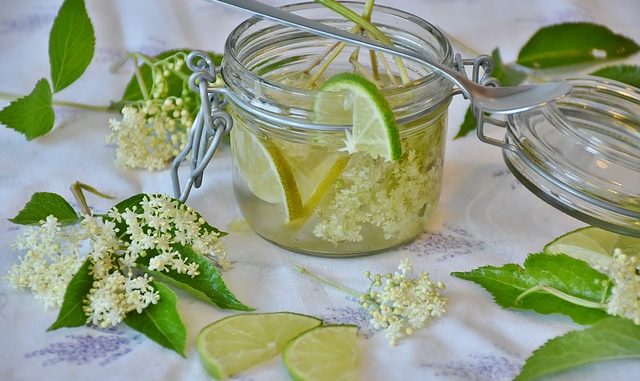
The Elderflower (species: Sambucus nigra Family: Caprifoliaceae), or Sambucus, is a shrub growing all over the world. It is mostly found throughout the Northern hemisphere and has been much revered in various parts of Europe, especially Austria and Turkey. The flower is rich in bioflavanoids and flavanols, giving it antioxidant, anti-inflammatory and antibacterial properties and making it powerful in combatting colds and flu. The rich purple berries too produce a highly distinctive flavoured juice. We discuss the berries in a separate article because the juice produced from these have different properties.
About 24 species are known in the Elder family. We have Sambucus nigra – Black Elder, European elder, Elderberry; Sambucus mexicana – Mexican Elder; Sambucus adnata – Asian Dwarf Elder; Sambucus racemosa – European Red Elder; Sambucus australasica – Yellow Elder.
Products Using Elderflower
I’ve tried two products recently using elderflowers. The diluted elderflower drink from Bottle Green (Gloucester, UK) and a pressé from Belvoir Fruit farms. The cordial from Bottle Green for me is always under diluted which is my personal preference because I like the sharp almost nettle-like, green taste that is then followed by a more warming note of the fruit. Carbonated water seems best with this type of product, and likewise, in Belvoir’s presse which has a slightly softer, less sweet but unctuous taste and with a pleasing distinctive floral aroma.
Elderflower Sensory Notes
The odour notes from the flowers which have been infused into a model acidified syrup are mainly cis-rose and nerol oxides, hotrienol and nonanal which give the characteristic elderflower aroma (Jorgensen et al., 2000) as determined by gas chromatography-olfactory methods (GC-O). The floral notes come specifically from linalool and its derivatives, α-terpineol, 4-methyl-3-penten-2-one and (z)-β-ocimene.
Availability
The organic dried flowers are available in 50g and 100g amounts from Pestle Herbs.
Uses
- Often used to treat constipation
- Used as a general antiseptic and anti-inflammatory although there is no firm clinical evidence for this benefit
- Used for colds and flu and respiratory conditions but especially alleviating the swelling from inflamed nasal passages,
- Elderflower is claimed to be used on the skin for its anti-inflammatory properties, and for conditions such as arthritis or swollen joints and bruises but there is no firm evidence for this
- Can be used as a mouthwash to reduce swelling in the gums
Uses For Constipation
A tea is prepared from elderflower, fennel, green anise fruit and senna flower is said to improve bowel movements in those who are constipated. The combination is only known to be possibly effective and there is not enough clinical evidence to prove this.
Uses for Nasal Swelling
Nasal swelling or sinusitis is said to be treatable using a combination product based on elderflower, verbena, cowslip flower, gentian root and sorrel. The combination may help with treating inflamed nasal passages but as such there is no firm clinical evidence for any improvement.
Typical herbal remedy products include Potter’s Herbals. More clinically developed products include SinuComp and Sinupret. A more comprehensive range is found in the section on coughs and colds.
There is not enough evidence available for the specific treatment of coughs, flu and cold. This also includes bronchitis and laryngitis (hoarseness).
Much more detail about the use of elderflower can be obtained from various web-sites such as WebMD which are worth consulting for their level of knowledge.
How To Prepare
Fresh or dried elderflower leaves are made into teas, cordials, oils and syrups. The berries are made into a syrup but MUST be cooked before use as they, the bark, twigs, leaves and roots contain toxins which need to be destroyed. The leaves, sticks and roots are never ingested under any circumstance.
Cautionary Information
- The berries, bark, twigs, leaves and roots can all be toxic and cause a build up of cyanide in the body
- Do not use while pregnant or nursing
- Do not give to any child under two years old.
Please note this page contains links to our affiliate marketing partner. Please read our affiliate disclosure.
Alternative Names
There are many other names for the elderflower shrub and these are:-
Arbre de Judas, Black-Berried Alder, Black Elder, Boor Tree, Bountry, Common Elder, Ellanwood, Ellhorn, European Alder, European Black Elder, European Black Elderflower, European Elderflower, European Elder Flower, Fleur de Sureau, Fleur de Sureau Noir, Flor de Saúco, Flos Sambuci, Hautbois, Haut Bois, Sambuc, Sambucus, Sambucus Flos, Sambucus Nigra Flos, Sambucus nigra, Seuillon, Sureau Commun, Sureau Noir, Sussier, Sweet Elder.
References
Jørgensen, U., Hansen, M., Christensen, L.P., Jensen, K. and Kaack, K. (2000) Olfactory and Quantitative Analysis of Aroma Compounds in Elder Flower (Sambucus nigra L.) Drink Processed from Five Cultivars. J. Agric. Food Chem., 48(6) pp. 2376-2386
Leave a Reply